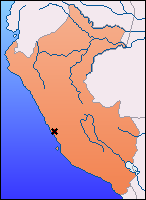 |
Related pages: |
During the pre-Hispanic period, a small town of very religious fishing men who lived in the Rimac valley was at the origin of Lima. Later, a culture developed there, becoming an important political and religious center; they built the Pachacamac sanctuary, place of pilgrimage, which archeological vestiges last until today. When the Incas came, they respected their religion, customs and let them venerate the Sun God and the Pachacamac God.
During the Hispanic period, Francisco Pizarro founded the city of Lima, known as the king's city, on January 18th, 1535 on the Rímac riverbanks. During the 17th and 18th centuries, its time of splendor, it became the political and military power center represented by the vice-monarch. For 282 years, under the Asturias and Bourbon dynasties, 40 vice-monarchs ruled in the Government palace. It was at the begin of this period of great religiosity that lived Santa Rosa de Lima, patroness of Peru, the Americas and Philippines; San Martín de Porres and San Juan Masías.
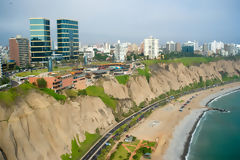 Lima,
which name comes form the Indian word Rimac (which translated in Spanish
means, speaker), began to grow quickly. We can see this from the remains
of millenary cultures that were developed in this area, to its transformation
during the 16th and 17th centuries in the most important and powerful metropolis
of Spanish America, center of the whole commercial and cultural activities of
the vice-monarchy.
Lima,
which name comes form the Indian word Rimac (which translated in Spanish
means, speaker), began to grow quickly. We can see this from the remains
of millenary cultures that were developed in this area, to its transformation
during the 16th and 17th centuries in the most important and powerful metropolis
of Spanish America, center of the whole commercial and cultural activities of
the vice-monarchy.
In the 18th century, began the decadence with the creation of the vice-monarchy of La Plata (Argentina, Paraguay and Bolivia). This allow Spanish to get back the famous mines of Potosí.
During the republican period, on July 28th, 1821, General José de San Martín proclaimed in Lima the independence of Peru, beginning this way the Republican period, up today. During the government of Marshall Ramón Castilla, Lima became the head city of Latin America: they built the first south American railroad linking Lima and the Callao harbor; the telegraph and gas lightning were installed, and black people slavery was abolished by the government.
The Lima department is located in the center of the Peruvian coast, in front of the Pacific Ocean and occupies a part of the mountain to the East, an area of 33,820 sq. km.
Lima, capital of Peru, is a modern city of 8 millions of people, where live the third of the population of the country.
Its coastal weather is tempered and humid. In summer (December to March) the average temperature is 25°C, which invites you to visit its beautiful beaches. In winter (June to September) it varies between 11°C and 15°C. In the mountain areas, during the day, the weather is tempered but it gets cooler at night.
Lima is overpopulated, contaminated, noisy and its weather is often sad. However, people from Lima are friendly and hospitable. Opportunities to go out for diner or to live by night are big. The city has a large variety of museums, markets, places, colonial constructions and a zoo.
The Miraflores district has the best stores in town (open from 9:30-10 am to 1 PM and from 4 PM to 7-8 PM), many restaurants and a nice nightlife.
Because of earthquakes, almost nothing remains of the period of Lima's foundation, in 1535, (the latest big one in 1746). As in most of the capitals of Latin America, the Centro is mostly inhabited by the poorest people. Architecturally, it has a undeniable disjointed character. However, we can see behind a few dirty facades, some jewels of colonial architecture. People use to denigrate the Centro. It's a little unfair. Beyond its dirt and its decadent side, there is a real life. You can see this in its crazy animation during the day.
On the other Rio's bank lies the Rímac district which was also, before, one of the upper-crust districts of Lima
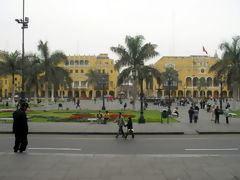 Completely renovated, it shows a remarkable arrangement of colonial buildings.
On the left, the City Hall (Calbido), on the center, the Government
Palace and on the right the cathedral. Its restricted automobile circulation
gives a charming panoramic vision.
Completely renovated, it shows a remarkable arrangement of colonial buildings.
On the left, the City Hall (Calbido), on the center, the Government
Palace and on the right the cathedral. Its restricted automobile circulation
gives a charming panoramic vision.
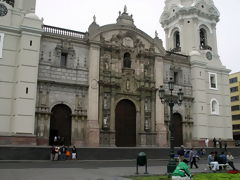 Since
the foundation of Lima, they built a sanctuary in his location, but the
actual construction dates from 1746. Its wood pillars protected it from a complete
destruction during the earthquakes. Its facade is austere (because of the influence
of Herrera) and the interior a little sad. Beautiful choir stalls surrounded
by two carved pulpits. On the left of the altar is the museum of religious art.
It's a collection of chasubles embroidered with gold, a polychrome wood statuary,
paintings on glass. Also an interesting painting of the big sacristy The
Dynasty of the Incas, beautiful furniture, secretaries with ivory marquetry,
carved cupboards, cult objects inlayed with mother-of-pearl, Christ of ivory,
paintings of the Cuzco school. In the chapter room there are portraits
of the archbishops of Lima. Along the naves there are chapels richly
decorated behind carved wood bars (in one of them is the tomb of Francisco
Pizarro).
Since
the foundation of Lima, they built a sanctuary in his location, but the
actual construction dates from 1746. Its wood pillars protected it from a complete
destruction during the earthquakes. Its facade is austere (because of the influence
of Herrera) and the interior a little sad. Beautiful choir stalls surrounded
by two carved pulpits. On the left of the altar is the museum of religious art.
It's a collection of chasubles embroidered with gold, a polychrome wood statuary,
paintings on glass. Also an interesting painting of the big sacristy The
Dynasty of the Incas, beautiful furniture, secretaries with ivory marquetry,
carved cupboards, cult objects inlayed with mother-of-pearl, Christ of ivory,
paintings of the Cuzco school. In the chapter room there are portraits
of the archbishops of Lima. Along the naves there are chapels richly
decorated behind carved wood bars (in one of them is the tomb of Francisco
Pizarro).
On one side of the cathedral, is the archbishop's palace with its beautiful Baroque style facade and its wood carved balconies. In front of this palace, on the other side of the street, is the Casa del Oídor (the Judges House), one of the oldest Lima's houses and only witness of the civil architecture of the beginning of the city. But the oldest house is located at the end of Unión Street, in front of the Government Palace. It's the Aliaga's House, which dates from the early years of the city.
Around the place are two of the oldest cinemas of Lima, and also the ancient building of the Bolívar Hotel, one of the most beautiful of the city. A little anecdote of this place is that when they ask the Spanish artist to sculpt a woman representing liberty, they ask him to put a flame (llama in Spanish) on the head, but the artist, thinking about the country where he was, put a llama (llama, the animal, also is Spanish). You can see it today on the statue's head.
Located in the third block (cuadra) of Ancash Street, the San Francisco convent and church and the churches of Soledad and Milagro the biggest colonial architecture complex of the country. The church has a very nice stone facade; the convent, the cloister and the reception are decorated with precious faïence tiles from Seville installed in 1620, with nice bars paneled walls.
We can note also the Religious Art museum, rich in silver objects, chasubles embroided with gold and silver, fine carved wood, parchments, ostensories, etc.
The Zurbarán Street with its paintings of the Apostles. In the underground galleries we find the Catacombs, discovered in 1951, which used to be a cemetery during the colonization.
Located on the Conde de Superunda Street, at the corner of the Camaná Avenue, this construction was finished by the end of the 15th century. In the altar, on the left side, they pray to the Rosario Virgin, and on the right side is the altar of the Peruvian Saints: Santa Rosa de Lima, San Martín de Porras and San Juan Masías. Below each one, we find silver urns containing their relics. The cupola is very beautiful, one of the most beautiful of the city.
The convent, with beautiful cloisters, is decorated with faïence tiles from Seville and the chapter room with Baroque style carved wood. The San Marcos University was founded there in 1551.
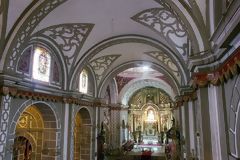 The
church of San Pedro's, was built on the location of the Naturales
hospital, in 1668. The main architect was Juan Tomas Tuyro Tupac. The
interior is of an elegant sobriety. The church has many paintings, sculptures,
objects in carved wood and important golden decorations. The same artist carved
the pulpit.
The
church of San Pedro's, was built on the location of the Naturales
hospital, in 1668. The main architect was Juan Tomas Tuyro Tupac. The
interior is of an elegant sobriety. The church has many paintings, sculptures,
objects in carved wood and important golden decorations. The same artist carved
the pulpit.
This museum is remarkable for its excellent vestiges of the prehistoric Peru.
You can find many gold, silver and precious stone objects.
The church and convent of La Merced, San Agustín church, Las Nazarenas church, the convent of los Descalzos, San Marcelo church, the sanctuary of Santa Rosa, the Huacas, the National History Museum, the Nation museum, the Amano museum, the Italian art museum, the Banco Central de Reserva museum, the Banco Wiese museum, The Art Museum, the Larco Herrera museum, etc.